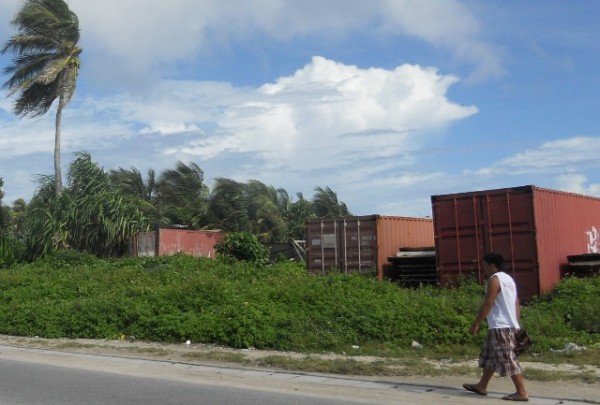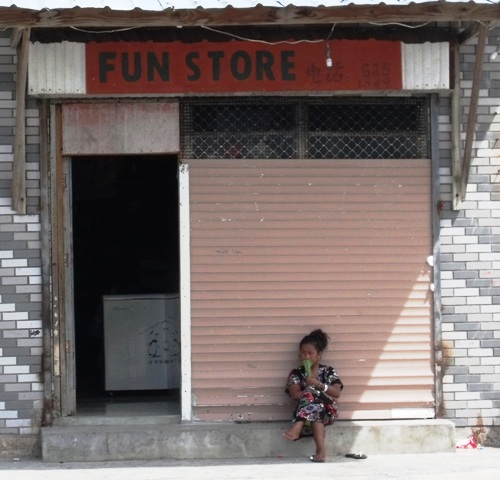Taking in the surroundings of Eneko Island it’s easy to conclude you’ve walked into a photograph on a postcard. Part of the Majuro atoll in the Marshall Islands, the private island ticks all the boxes for a popular view of paradise. White sandy beach, clear turquoise water, palm trees leaning gently over the ocean; all the ingredients of a perfect place and not a soul in sight to spoil it.
Yet anyone coming to the Marshall Islands for a slice of paradise is likely to get a bit of a shock. While these islands, isolated in the mid-Pacific more than 2000 miles west of Hawaii and 3000 miles east of Manila, do have their idyllic spots poverty and decay are a far more common backdrop than white sand. The road from the airport to the main town of Majuro is lined with rusty shipping containers and many abandoned cars, left to rot in the tropical sun. You’ll be hard pressed to find more than half a dozen buildings in town that boast any architectural merit, with an abundance of corrugated iron and dull grey concrete blocks used to make the buildings that pass for homes and shops. Whatever Majuro is, it ain’t pretty.
A tourist can hardly be expected to appreciate the extent of any country’s social problems during a short visit and in the case of the Marshall Islands that’s probably just as well. Along with the rest of Micronesia the levels of child abuse here are very high and while it doesn’t make good pre-holiday reading this Micronesian Seminar article provides a shocking insight into the scale and causes of these problems. If you read this before you go I can guarantee you’ll be reminded of it when you see a group of children playing in the back streets of Majuro.
The Marshall Islands were never meant to sustain a large population. While fish has always been plentiful the tiny amount of available land is hardly sufficient to feed the current proportion. Perhaps this explains in part the dominance of instant noodles and spam in the local diet (obesity is a major problem).
And if shortage of liveable space was an issue before, continued American military presence has compounded this to an astonishing extent. Having established Bikini Atoll as their favoured site for nuclear testing in 1945, several dozen nukes made not only Bikini uninhabitable for future generations but also neighbouring islands, which received radiation levels so high that even now they are not considered safe for resettlement.
Then there’s the US massive military base at Kwajalein Atoll, which has led many Marshallese to work at the site. Many have been forced to live on the nearby island of Ebeye, where thousands have also been relocated as a long-lasting legacy of the nuclear testing programme. With a population of 15,000 crammed into a mere 80 acres, Ebeye is one of the most densely populated places in the world. With alarming rates of poverty and disease it has earned the unwanted label of the Ghetto of the Pacific.
If you have any doubt about the horrific consequences that the American nuclear tests had on the Marshallese population I would urge you to watch the film Nuclear Savage, made by American film-maker Adam Horowitz. The official site is here (contains a short trailer) and I’ve found the full 80 minute movie here on Vimeo (it’s in English but with Spanish subtitles). A very difficult film to watch and having watched the full movie while in our Majuro hotel I defy anyone to sit through it and not get extremely angry.
So why on earth, given my descriptions above, would anyone want to go to the Marshall Islands? They’re so far from anywhere, with poor flight connections each involving multiple stops in places that perhaps have far more to offer. A few divers come here to explore some of the most accessible and impressive wrecks in the world. We met a group of surfers on our first day – they were passing through, heading out onto a live-aboard boat for the next two weeks.
Yet I would say those who do make it out to the Marshall Islands will probably list it as one of their most memorable travel experiences. Highlights listed by the Visitors Authority are certainly low-key – they include a visit to a copra (coconut meat) processing factory and a canoe-building workshop (more on that in this article). But wherever we stopped by we were met with curiosity, warm smiles and willingness to show us whatever we wanted to see. We were even invited to a quiz night in one of Majuro’s few restaurants by an ex-pat we met on our wanders around the town.
By day five we were being greeted by toots of the horn and waves of recognition as we walked along the only road in town. We’d met several islanders who had opened up and shared with us their family history on Majuro and the neighbouring atolls and helped give us an appreciation of both the good parts and the problems of island life.
While we may not have seen any single sight that made Majuro unforgettable for us, we left with many happy memories of a time well spent. Beyond the grubby exterior of Majuro there was more than enough to make us glad we came.







Eek. I had no idea that these kinds of problems existed in the Marshall Islands. I always assumed that it would be a typical Pacific paradise, not plagued by poverty and all the accompanying social problems that go with it. I’m glad you enjoyed your time there, though – and thanks for the education!
Eight years ago I lived on Majuro and taught the fourth grade at a local school for 10 months. It was an eye opening experience–about the issues your highlighted among other things–and one of the most important years of my life. Marshallese people are extremely warm and generous people with a great creative spirit. Just yesterday I found myself missing the Marshallese style music I’d regularly hear in the shops or sung by the kids in the playground.
Glad to read your account Kirsten and to see that you had a similar experience. It’s a strange place but if I ever had the chance to return I’d certainly take it. I wish I’d heard more of the Marshallese music though – next time 🙂
I wish we could do something for those people, it is so nice and beatifull place